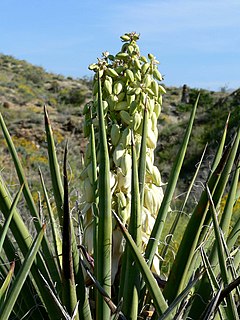
Yucca schidigera, also known as the Mojave yucca or Spanish dagger, is a flowering plant that is native to the Mojave Desert, Chihuahuan Desert and Sonoran Desert of southeastern California, Baja California, New Mexico, southern Nevada and Arizona.

Calliandra is a genus of flowering plants in the pea family, Fabaceae, in the mimosoid clade of the subfamily Caesalpinioideae. It contains about 140 species that are native to tropical and subtropical regions of the Americas.

Cladrastis kentukea, the Kentucky yellowwood or American yellowwood, is a species of Cladrastis native to the Southeastern United States, with a restricted range from western North Carolina west to eastern Oklahoma, and from southern Missouri and Indiana south to central Alabama. Also the tree is sometimes called Virgilia.
Brownea santanderensis is a tree in the family Fabaceae, native to Colombia. It is named for Colombia's Santander Department.

Plathymenia reticulata is a species of legume native to much of eastern South America. It is placed in its own genus, Platyhymenia, although other species have previously been recognised in that genus. It grows up to 30 m (98 ft) tall, and has distinctive flattened seed pods. Its wood is rot-resistant, and is widely used as a structural timber.

Peltophorum pterocarpum is a species of Peltophorum, native to tropical southeastern Asia and a popular ornamental tree grown around the world.
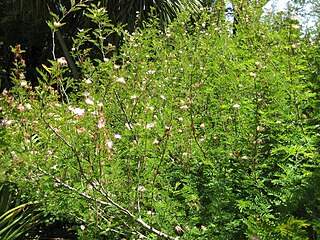
Zapoteca is a genus of flowering plants in the legume family, Fabaceae, in the mimosoid clade of the subfamily Caesalpinioideae. It was separated from the genus Calliandra in 1986 on the basis of chromosome numbers, pollen, seedling structure, and other features. It is named in honour of the Zapotec peoples.

Yucca × schottii is a plant species in the genus Yucca, native to southern Arizona, southwestern New Mexico, and the northern parts of Sonora and Chihuahua. The common names are Schott's yucca, hoary yucca, and mountain yucca. The "×" in the name indicates that this is a nothospecies, regarded as being a natural hybrid between two other species. In this case, Yucca × schottii is believed to have originated as a hybrid between Y. baccata and Y. madrensis. Yucca × schottii is firmly established and does reproduce freely in the wild.

Passiflora suberosa is a species of passionflower that is native to the Americas. It is commonly known as corkystem passionflower due to the corkiness of older stems. Other common names include corky passion vine, cork-bark passion flower, corkstem passionflower and corky passionfruit. It is possibly also cryptic and have multiple species in one.
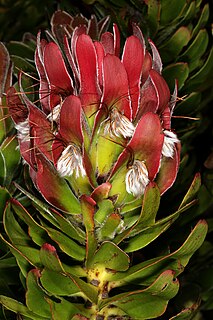
Mimetes fimbriifolius, also called cowl pagoda or the fringed pagoda, is a species of plant in the family Proteaceae. It is a dense, rounded, multi-branched tree that grows up to 4 metres in height. This attractive and striking plant flowers all year round, and produces red and yellow branch-heads and inflorescences. The nectar-rich flowers are pollinated by sunbirds and the seeds are distributed and taken underground by ants before germinating. It is endemic to the Table Mountain range in the city of Cape Town, South Africa.

Yucca potosina, English common name Potosí palm soapwort or Potosi palm, Rzed. is a plant species in the family Asparagaceae, native to the east central Mexico from Hidalgo to San Luís Potosí. It is sometimes cultivated as an ornamental, but not widely.
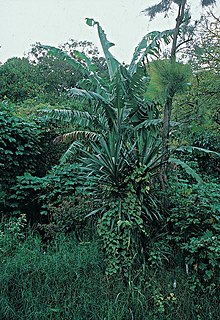
Yucca lacandonica is a plant species in the yucca genus with the common name "tropical yucca." It is native to Belize and to southern Mexico, the states of Chiapas, Veracruz, Tabasco, Quintana Roo, Campeche, and Yucatán. It is uniquely the only epiphytic species in the genus, although it has been reported to grow terrestrially as well.
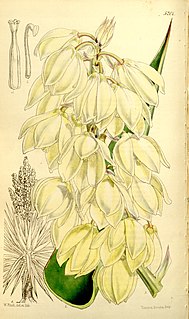
Yucca treculeanaCarrière is a plant in the family Asparagaceae, native to Texas, New Mexico and Coahuila. Common names include Spanish dagger, Spanish bayonet and Don Quixote's lance.
Mariosousa usumacintensis is a plant species native to the Mexican State of Tabasco. It was named after the Río Usumacinta, near the location where the type specimen was collected.

Erythrina flabelliformis, common name chilicote or western coral bean, is a plant species native to central and northwestern Mexico and the southwestern United States. It is known from Baja California as far south as Morelos and as far east as San Luis Potosí, as well as from Arizona and New Mexico.

Dalbergia armata is a scrambling, deciduous species of legume that is native to subtropical to temperate regions of southeastern Africa. The robust, woody liana or small tree is armed with strong spines on the main stem and branches. It occurs sparsely or commonly in forest, bush, riparian fringes and in wooded ravines. It is sometimes employed as a bonsai subject, and it can be propagated from either seed or cuttings.
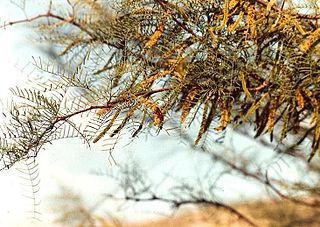
Prosopis chilensis is a species of tree in the genus Prosopis, belonging to the family Fabaceae. It is found in parts of central Chile, southern Peru, Bolivia, and Andean (northwestern) Argentina. Its common names include Chilean mesquite, cupesí, and Chilean algarrobo. It is used for providing shade, for animal feed and for firewood.
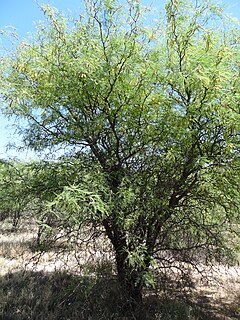
Prosopis flexuosa, commonly known as tortuous mesquite and a variety of Spanish vernacular names including algarrobo dulce and algarrobo negro, is a species of flowering tree in the genus Prosopis of the family Fabaceae. It is found in arid and semi-arid regions of Argentina, Bolivia and Chile, including the western Gran Chaco and the Monte Desert, where it is a conspicuous and characteristic plant of the region. Its timber is used for construction, charcoal and fuel and its fruits are eaten by humans and livestock.

Erythrina berteroana is a species of small deciduous tree in the family Fabaceae. It is found in Mexico, Central America and the northern part of South America. Common names include elequeme, gallito, machete, pernila de casa, pito and poró de cerca. It is a common tree in the drier parts of its range and has many traditional uses.
Brownea enricii is a tree in the family Fabaceae, native to Colombia. It is named for the Colombian botanist Enrique Forero.
















